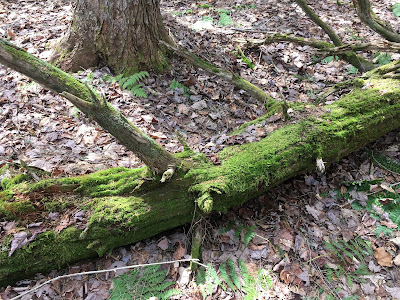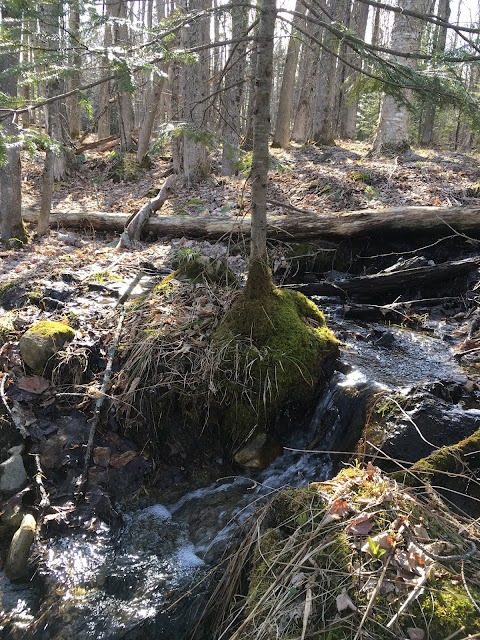220503 their naked selves
april 25
It seems a long time since the forest became naked, disrobed of snow. I was afraid it would be fleeting, and I wanted to know it better like this. I can see its roots, its dead, and its broken limbs, among the rocks, and walk where I can't go, once the undergrowth has covered up everything. When ferns and brambles and green life have filled up the spaces, one cannot see one's footing or the swampy places and is forced onto the paths again and open meadow. But it has gone on, like something sleeping, or just breathing, for a couple of weeks. (April has been a waiting time.) Underfoot is papery leaves lain thin on rock and root, dry knoll and wet hollow, like the skin of an old woman. The trees are their naked selves, trunk and branch.
The trees live among their dead and fallen. A grandfather long dead may stand branchless among the living, on and on. A mature tree may be knocked down in a storm and crash among the other trees, bringing some down with it, or leaving its branches or even its whole trunk caught in another tree. That tree receives the burden of the fallen thing, carries it in its own branches ever after, or perhaps grows new limbs around it. The fallen tree may die, or it may go on for years, adjust to life at an angle, supported by the strong limbs of its neighbour tree. Or a tree may bear its own broken limb, torn off in a storm, caught in its branches, ever a burden to be carried. Young trees grow and root among the stones and fallen logs and form themselves to the dead and wounded, twisting and bending to find their way up to the sun. Long after a dead log is gone to earth, the roots and the tree bodies that grew on it are twisted about that history, like something remembered always. Each tree has found a place to live and accepted the vagaries of its life, finding ways around its forest mates, and being that tree. There are many species, which each have their pattern, and adaptabilities. They are of all ages, from sprouting, to slim adolescent, to mature strong adults. And there are the old and infirm, alive and participating in forest life, just by being there: just being there.
 This grandfather tree still stands, long dead, home for mosses.
This grandfather tree still stands, long dead, home for mosses.

The trees bear human-like traits, to me as a human observer, and perhaps to each other. There are mother trees, with their offspring growing in their shelter. Some are protector trees who have doubtless had their jobs thrust upon them because of where they grew, able to reach maturity tall and strong and be a shelter and sentinel for their fellows. I may only project this framework onto them, but I begin to see that a metaphor may be as useful as a fact when one wants to understand a thing. The trees are all interconnected, by root and shared space, branch, and leaf too: in autumn all the leaves are cast onto the ground to be earth in the coming summers. [For more on "mother" trees, and the life of forests I will refer you to Suzanne Simard. *]
This ancient tree was allowed to live because it grew by a boulder that could not be cleared from the meadow by the first farmers who came here. It is still alive though much of its body is dead and decrepit.
This giant stands, a king tree, at the edge of the meadow. Even he carries a great, dead limb of his own in his branches.
Humans, then, as trees in the forest. Each of us is different, each bringing something to the table, each showing up. We carry, in our minds, and sometimes in our bodies, our loved ones and our dead, burdened with a "limb" of the living or gone, that has fallen on us. We carry our own dead branches, and our roots are twisted about the shapes of our ancestors and the stones of our own place in the world. We bury our dead, but we carry them with us, gene and history and ancestral memory, and the stories our mother told about her grandmother, the recipes passed down, the literal and the metaphorical. We come to the human community with this history, these burdens. They influence who we are and how we act.
Like the trees, we do not exist as individuals. We are part of the fabric of the human forest, and the earth as a whole. No thing is an island. It must live in and with the world. This speaks to community, local and global. We must "show up" not just in our family circle but also in the wider community, and, because we are now a global species, in the world. We must carry our share of the burdens, support and nurture those around us, weak and strong. We need each other, for sustenance, shelter, and care, and for teaching, remembering, social interaction. We are none of us straight and tall enough to stand all by ourselves. I think of how we label "able", "disabled", or different, label by skin-colour, gender, beauty and ugliness. Many years ago, when I was getting to know my daughter, Tamar, we were attempting to organize her room, and she said to me that she did not perceive "categories" of things. Each object was its own "category", so how could one gather them into groups? In recent days I have come to understand what she saw. Each thing has its own being, purpose, place, history, story. Each of us has, too. Categorizing, or labeling, results in division, in reducing people to a small snapshot of who and what they are. It takes away from their wholeness, excludes by its reduction, so much of the value each life brings to the world. Their simply "being", alters the fabric of the world around them. Every person has a "superpower", something they bring to the table, or the human forest, if you will. *** Every person also is burdened with handicaps: physical and psychological, historical and social. They have "grown around" a physical challenge, around the impacts of childhood and their adult experiences. Their internal landscape shows the broken limbs and fallen logs of the dead and the past, that they carry through their lives.
In an important way we are different from the trees. Although like them we cannot choose where we were born, nor how we grew up, we can sometimes shake off the mental and emotional burden of some of our hurts, the broken "limbs" we carry. **** We can sometimes escape an unhealthy relationship, overcome loss and grief and broken dreams. Whether we wish to or not, we go on trying to reach the sun, to carry on with life. We can also choose to support and nurture those around us, in family and community. "We all need someone we can lean on." We all need someone to help us carry our mattress. *5, *6
Thank you for visiting. Be well.
Mumma Yaga
In the forest the greening has begun:
* https://suzannesimard.com/finding-the-mother-tree-book/
*** The Rookie, CTV TV series, Season 4, Episode 18: Sgt. Bradford says to his rookie, "... by figuring out your superpower. Every cop has one." In this context, every person has one.
**** Or did we choose to whom we were born? I often feel that I am in this life for some purpose. I know that I am supposed to be learning how to listen.
*5 Let it Bleed, The Rolling Stones, 1969
*6 Tamar, at four years old, while we were discussing how a child grows up and moves into their own home: "I will need someone to help me carry my mattress."
end.




















Comments
Post a Comment